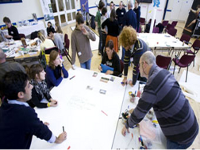Case study - IT Systems Transformation

The result: A consulting firm delivered a complex multi-stakeholder strategy project to a government agency, almost entirely using Southbeach Notation. A year later, the lead consultant visited the client for an update, and ran a short workshop for the stakeholders. The welcome he got on arrival and their response in the meeting prompted him to write to the COO. Southbeach was enabling people from different business areas to openly collaborate, enabling them to develop a shared plan for how to achieve their goals.
Working with Southbeach
Southbeach can be applied by one person, a small team, or a larger group. In a team setting, people work face-to-face, remotely, or in some combination that befits their work style and project need. Start with small models. Try not to be over rigorous at first. Encourage participation in the development of a small number of shared models.
Models that emerge from early work can later be combined with each other. They become the starting point for larger, more structured workshops. One person or a lead consultant usually leads the charge, interviewing colleagues, talking to the client, integrating the elements, and then distributing models for comment. In a major project, expect to develop many such models from each important perspective.
In the words of the lead consultant
“I ran a workshop with thirty people and thirteen Southbeach models created over the last six weeks. Nine of these were printed on large sheets of paper, roughly six table tennis tables worth.
I split people into two teams and gave them red, green, and blue pens to add useful enablers, resources, benefits, and goals as well as constraints, blockers, and harmful side effects and actions to achieve the desired future state.
We went through four models that were to align perspectives of four departments in the corporation, which I created through individual interviews with the heads of each division. We then went through a model showing the major issues they had to overcome to achieve their vision. We then drilled into nine of the blocks on this model.
First I gave an overview of the issue, the options, the useful and harmful side effects of each option, and then why we had made a certain recommendation. Then I sent them to the back of the room in two teams to elaborate the model. After ten minutes, I got them to swap and review and comment on each other’s comments. The two teams then came to listen to my description of the next model.
After all models were assessed, we engaged in a group discussion on how to move things forward, which I captured as a further model. They loved it. Many of them came up to me and thanked me for the day, saying that it was very useful, and we proceeded to talk further about how to change the ideas in the models into reality.
Most of these clients had not seen Southbeach before. The first model they brainstormed was slow to develop. By the second model they had picked it up. Everyone agreed this technique had enabled many people from different groups to collaborate in a way they had not collaborated before. The Southbeach notation enabled this 'visual' conversation.
The team enjoyed working with Southbeach and were excited about the possibilities for future projects.
The approach in this project
In this project, the various models that were developed by the consultant and her team represented different slices, or perspectives, of the overall situation. This helped the team organize the work in the project and afterwards during implementation:
- By structure: Different layers in the IT (e.g. Infrastructure, Applications, Business)
- By time: Present, Future and How To Get There (the transformation journey)
This approach is the super-structure of many 'situational improvement' projects.
A year later
A year later, the lead consultant was invited back to the client at which they had previously delivered the strategy using Southbeach. The client wanted to move forward in some key areas of the strategy and were looking for help in planning an approach to this.
In the original project, Southbeach Notation had been used to explore options and to de-risk the overall program by mapping out the potential useful and harmful consequences of each option. The consultant was now asked deliver one of the recommended options.
As consultants are want to do, there was plenty of thinking beforehand and slides were prepared describing how actions could be moved forward. On arriving at the client site, the consultant was greeted with warm handshakes and smiles... but as he started presenting his slides, whilst there were nods, there was also frowning.
A disappointed face in the audience shouted out "I thought we were going to use Southbeach". The team did not want a pre-canned answer. They wanted to collaboratively explore possibilities and determine the best path to take based on a synthesis of perspectives on the pros and cons that would create stakeholder alignment. PowerPoint was closed and Southbeach Modeler was opened.
The COO reaction
There was a new Chief Operating Officer (COO) in the room. He had not seen Southbeach before. After a twenty second introduction, "Red is harmful, green is useful, arrows show cause and effect, solid green boxes represent goals etc", the consultant started drawing up what had just been said.
Enablers were drawn as green boxes with production arrows leading to various useful outcomes that finally contributed to the goals in solid green boxes. Of course, there were also constraints and blockers in red boxes, counteracting some of the desired outcomes, so mitigations were added either as blue action boxes or further green boxes indicating useful resources that could aid in delivery.
As the conversation unfolded, the COO got it immediately. "Ah... I can see the value of this".
